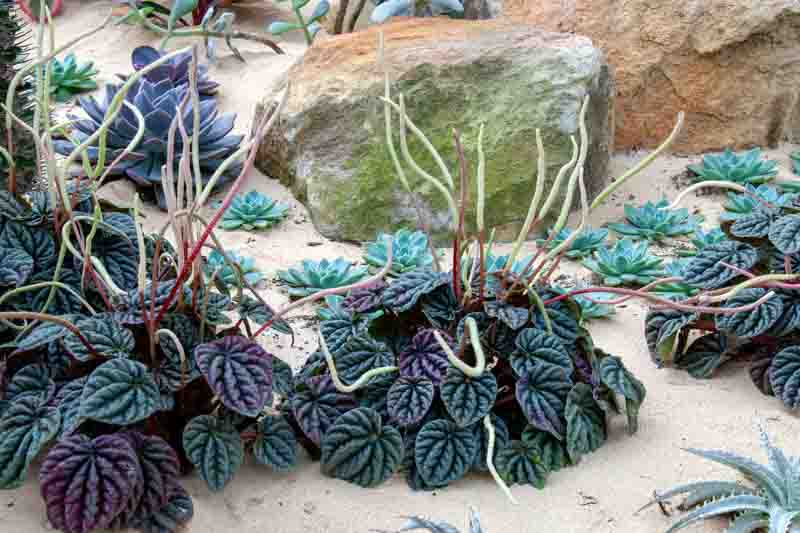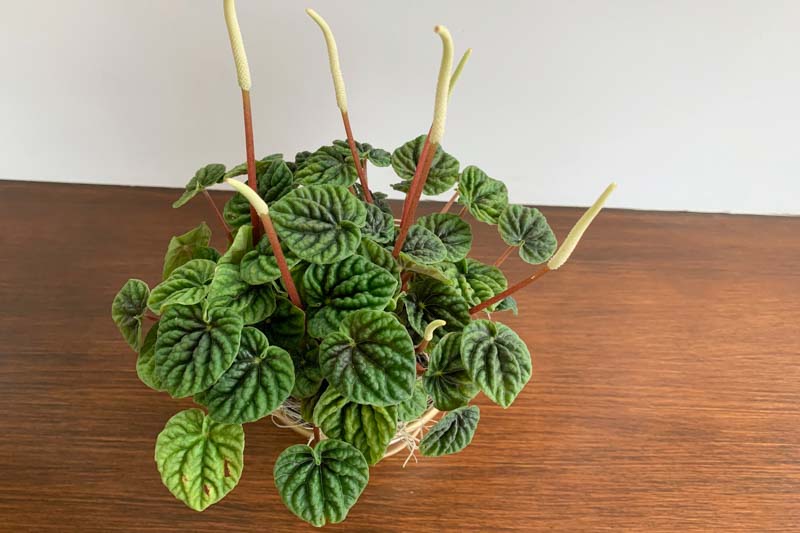Emerald Ripple Peperomia, Ripple Peperomia, Green Ripple Pepper
Peperomia caperata, commonly known as Emerald Ripple Peperomia, is a visually striking houseplant appreciated for its unique texture and ease of care.
Peperomia caperata is distinguished by its deeply corrugated, heart-shaped leaves that come in a variety of colors, from rich green to silver, and even red or purple hues. The leaves’ unique rippled texture adds depth and interest, making it a standout addition to any plant collection.
Native: This species is native to Brazil where it grows in the understory of rainforests, thriving in moist, humid conditions with filtered light. It belongs to the pepper family (Piperaceae) and is part of a diverse genus with over 1000 species.
Plant Type and Habit: Peperomia caperata is a perennial evergreen that exhibits a compact, mounding growth habit, with leaves emerging from the central stem, creating a dense, lush appearance. This plant is well-suited for growth as a houseplant due to its moderate size and decorative foliage.
Size: The Emerald Ripple Peperomia typically reaches about 8 inches (20 cm) in both height and spread, making it an ideal choice for small spaces, tabletops, or terrariums. Its compact nature allows for easy placement in a variety of indoor settings.
Flowers: Peperomia caperata produces slender, rat-tail like flower spikes that extend above the foliage. While the flowers are not particularly showy compared to the dramatic foliage, they add an interesting textural element when they appear.
Foliage: The foliage is the main attraction of Peperomia caperata, with each leaf featuring deep grooves and ridges that create a striking ripple effect. The leaves can vary in color among different cultivars, offering a range of options for collectors and enthusiasts.
Hardiness: It is suited for USDA hardiness zones 10 to 12 if grown outdoors. Indoors, it prefers temperatures between 65°F and 75°F (18°C to 24°C) and moderate to high humidity levels.
Uses: Its unique textured foliage and compact size make it a popular choice for enhancing indoor environments, from homes to offices. Its small size and humidity tolerance make it suitable for inclusion in terrariums and dish gardens, where its textured leaves can be fully appreciated up close.
Toxicity: Peperomia caperata is non-toxic to cats, dogs, and humans, making it a safe addition to households with pets and children.
Benefits: Though modest, it contributes to improving indoor air quality.

Caring for Peperomia caperata, commonly known as Ripple Peperomia, involves a balance of proper lighting, watering, humidity, soil, and fertilization to mimic its natural tropical environment.
Light: Prefers bright, indirect light. Avoid direct sunlight, which can scorch its leaves, but ensure it gets enough light to maintain its vibrant leaf coloration and compact growth form. A spot near a window with a sheer curtain is ideal for diffusing light.
Soil: Use a well-draining potting mix to prevent root rot. A mix designed for succulents or cacti, which typically includes perlite or sand for improved drainage, is a good choice. Ensure the pot has drainage holes to allow excess water to escape.
Water: Water when the top inch of soil feels dry to the touch. Peperomia caperata dislikes being waterlogged, so be careful not to overwater. Reduce watering in the winter when the plant’s growth naturally slows down.
Temperature and Humidity: Keep it in a warm environment, ideally between 65°F and 75°F (18°C to 24°C). Protect it from cold drafts and sudden temperature changes, which can stress the plant. Thrives in high humidity, similar to its native rainforest habitat. However, it can adapt to average household humidity levels. To increase humidity, you can mist the plant regularly, use a pebble tray with water, or place a humidifier nearby.
Fertilization: Feed with a diluted, balanced liquid fertilizer once a month during the growing season (spring and summer). Avoid over-fertilizing, as this can harm the plant. No need to fertilize in the fall and winter when the plant is not actively growing.
Pruning: Pruning is rarely needed but can be done to remove any yellow or damaged leaves and to maintain the plant’s shape. Use clean, sharp scissors to make any cuts.
Repotting: Repot only when necessary, typically every 2-3 years or when the plant has outgrown its pot. Choose a pot only slightly larger than the current one to avoid overwatering.
Propagating Peperomia caperata, commonly known as Ripple Peperomia, is a straightforward process that can be achieved through leaf cuttings or stem cuttings. Here’s how to do it:

Peperomia caperata is generally resilient and low-maintenance but, like all plants, it can encounter its share of pests, diseases, and common problems.
Spider Mites: These tiny pests can be identified by the fine webs they weave on the plant. They cause yellowing or speckled leaves. Increase humidity around the plant and wash it with a strong stream of water. For severe infestations, use insecticidal soap or neem oil.
Mealybugs: These white, cottony pests tend to cluster in leaf axils and under leaves, sucking sap and weakening the plant. Remove with alcohol-dipped cotton swabs or apply neem oil.
Fungus gnat: Overwatering can lead to these pests. Let the soil dry out more between waterings, and use yellow sticky traps to catch adult gnats.
Scale insects: Hard or soft-bodied insects that attach themselves to the stems or leaves, causing yellowing and growth stunting. Scrape off with a fingernail or use a cotton swab dipped in rubbing alcohol. Insecticidal soap or neem oil may also be used.
Root rot: Often a result of overwatering, leading to brown, mushy roots and wilted leaves. Prevent by ensuring good drainage and letting the soil partially dry between waterings. Affected plants may need repotting with fresh soil after cutting away any rotten roots.
Leaf spot: Fungal or bacterial infections causing spots on leaves. Avoid wetting foliage when watering and improve air circulation. Remove affected leaves and treat with fungicides if necessary.
Drooping Leaves: Can be caused by either under or overwatering. Check the soil moisture and adjust your watering schedule accordingly.
Leaf Loss: Sudden changes in temperature, light, or watering can stress the plant, leading to leaf drop. Try to maintain a consistent environment for your Peperomia caperata.
Leggy Growth: Insufficient light may cause the plant to stretch towards the light source, resulting in leggy growth. Move your plant to a brighter location with indirect sunlight.
Peperomia plants are believed to have air-purifying qualities, absorbing small amounts of toxins from the air. While not as potent as some other houseplants in purifying air, they contribute to a healthier indoor environment by releasing oxygen, making them a beneficial addition to homes and offices.
Peperomia is an excellent indoor plant cherished for its low maintenance, variety, and compact size. Its ability to thrive in moderate to low light and its non-toxic nature make it a versatile and safe choice for decorating homes and workplaces, appealing to both seasoned enthusiasts and beginners.
Peperomia leaves may fall off due to care issues such as overwatering, underwatering, or inadequate light. Environmental stress and pests can also cause leaf drop. However, with proper care—correct watering, sufficient light, and stable conditions—Peperomia plants can remain lush and healthy.
| Hardiness |
10 - 12 |
|---|---|
| Plant Type | Houseplants, Perennials |
| Plant Family | Piperaceae |
| Genus | Peperomia |
| Exposure | Partial Sun |
| Season of Interest |
Spring (Early, Mid, Late) Summer (Early, Mid, Late) Fall Winter |
| Height |
6" - 8" (15cm - 20cm) |
| Spread |
6" - 8" (15cm - 20cm) |
| Spacing |
6" - 8" (15cm - 20cm) |
| Maintenance | Low |
| Water Needs | Average |
| Soil Type | Loam, Sand |
| Soil pH | Acid, Neutral, Alkaline |
| Soil Drainage | Moist but Well-Drained |
| Characteristics | Showy, Evergreen |
| Garden Uses | Patio And Containers |
| Hardiness |
10 - 12 |
|---|---|
| Plant Type | Houseplants, Perennials |
| Plant Family | Piperaceae |
| Genus | Peperomia |
| Exposure | Partial Sun |
| Season of Interest |
Spring (Early, Mid, Late) Summer (Early, Mid, Late) Fall Winter |
| Height |
6" - 8" (15cm - 20cm) |
| Spread |
6" - 8" (15cm - 20cm) |
| Spacing |
6" - 8" (15cm - 20cm) |
| Maintenance | Low |
| Water Needs | Average |
| Soil Type | Loam, Sand |
| Soil pH | Acid, Neutral, Alkaline |
| Soil Drainage | Moist but Well-Drained |
| Characteristics | Showy, Evergreen |
| Garden Uses | Patio And Containers |
How many Peperomia caperata (Emerald Ripple Peperomia) do I need for my garden?
| Plant | Quantity | |
|---|---|---|
| Peperomia caperata (Emerald Ripple Peperomia) | N/A | Buy Plants |
Create a membership account to save your garden designs and to view them on any device.
Becoming a contributing member of Gardenia is easy and can be done in just a few minutes. If you provide us with your name, email address and the payment of a modest $25 annual membership fee, you will become a full member, enabling you to design and save up to 25 of your garden design ideas.
Join now and start creating your dream garden!
Create a membership account to save your garden designs and to view them on any device.
Becoming a contributing member of Gardenia is easy and can be done in just a few minutes. If you provide us with your name, email address and the payment of a modest $25 annual membership fee, you will become a full member, enabling you to design and save up to 25 of your garden design ideas.
Join now and start creating your dream garden!